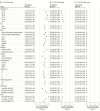Changes in Outpatient Health Care Use After COVID-19 Infection Among Veterans
- PMID: 38334995
- PMCID: PMC10858406
- DOI: 10.1001/jamanetworkopen.2023.55387
Changes in Outpatient Health Care Use After COVID-19 Infection Among Veterans
Abstract
Importance: The association of COVID-19 infection with outpatient care utilization is unclear. Many studies reported population surveillance studies rather than comparing outpatient health care use between COVID-19-infected and uninfected cohorts.
Objective: To compare outpatient health care use across 6 categories of care (primary care, specialty care, surgery care, mental health, emergency care, and diagnostic and/or other care) between veterans with or without COVID-19 infection.
Design, setting, and participants: In a retrospective cohort study of Veterans Affairs primary care patients, veterans with COVID-19 infection were matched to a cohort of uninfected veterans. Data were obtained from the Veterans Affairs Corporate Data Warehouse and the Centers for Medicare & Medicaid Services Fee-for-Service Carrier/Physician Supplier file from January 2019 through December 2022. Data analysis was performed from September 2022 to April 2023.
Exposure: COVID-19 infection.
Main outcomes and measures: The primary outcome was the count of outpatient visits after COVID-19 infection. Negative binomial regression models compared outpatient use over a 1-year preinfection period, and peri-infection (0-30 days), intermediate (31-183 days), and long-term (184-365 days) postinfection periods.
Results: The infected (202 803 veterans; mean [SD] age, 60.5 [16.2] years; 178 624 men [88.1%]) and uninfected (202 803 veterans; mean [SD] age, 60.4 [16.5] years; 178 624 men [88.1%]) cohorts were well matched across all covariates. Outpatient use in all categories (except surgical care) was significantly elevated during the peri-infection period for veterans with COVID-19 infection compared with the uninfected cohort, with an increase in all visits of 5.12 visits per 30 days (95% CI, 5.09-5.16 visits per 30 days), predominantly owing to primary care visits (increase of 1.86 visits per 30 days; 95% CI, 1.85-1.87 visits per 30 days). Differences in outpatient use attenuated over time but remained statistically significantly higher at 184 to 365 days after infection (increase of 0.25 visit per 30 days; 95% CI, 0.23-0.27 visit per 30 days). One-half of the increased outpatient visits were delivered via telehealth. The utilization increase was greatest for veterans aged 85 years and older (6.1 visits, 95% CI, 5.9-6.3 visits) vs those aged 20 to 44 years (4.8 visits, 95% CI, 4.7-4.8 visits) and unvaccinated veterans (4.5 visits, 95% CI, 4.3-4.6 visits) vs vaccinated veterans (3.2 visits; 95% CI, 3.4-4.8 visits).
Conclusions and relevance: This study found that outpatient use increased significantly in the month after infection, then attenuated but remained greater than the uninfected cohorts' use through 12 months, which suggests that there are sustained impacts of COVID-19 infection.
Conflict of interest statement
Figures




References
Publication types
MeSH terms
Grants and funding
LinkOut - more resources
Full Text Sources
Medical
Miscellaneous

